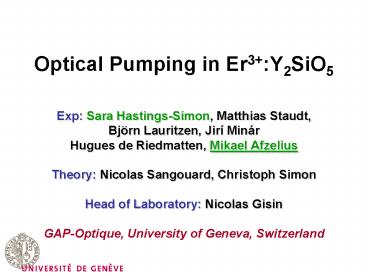Optical Pumping in Er3 :Y2SiO5 - PowerPoint PPT Presentation
1 / 16
Title:
Optical Pumping in Er3 :Y2SiO5
Description:
Bj rn Lauritzen, Jir Min r. Hugues de Riedmatten, Mikael Afzelius ... (CRIB, EIT, DLCZ, ....) Spectral tailoring for CRIB. wb. wb. Er3 :Y2SiO5 ... – PowerPoint PPT presentation
Number of Views:34
Avg rating:3.0/5.0
Title: Optical Pumping in Er3 :Y2SiO5
1
Optical Pumping in Er3Y2SiO5
- Exp Sara Hastings-Simon, Matthias Staudt,
- Björn Lauritzen, Jirí Minár
- Hugues de Riedmatten, Mikael Afzelius
- Theory Nicolas Sangouard, Christoph Simon
- Head of Laboratory Nicolas Gisin
- GAP-Optique, University of Geneva, Switzerland
2
Outline
- Background
- Motivation
- Spectral hole burning in Zeeman level systems
- Electronic spin lattice relaxation processes
- Experimental Results
- Spectral hole burning measurements
- Lifetimes of spectral holes
- Conclusions and Outlook
3
Motivation
- Optical pumping of ions for spectral tailoring
of the absorption - (CRIB, DLCZ)
- Optical lambda systems
- (CRIB, EIT, DLCZ, .)
Spectral tailoring for CRIB
Burn a hole
Absorption
wb
wb
w
Optical pumping
4
Er3Y2SiO5
- Two different sites site 1 1536.5 nm, site 2
1538.9 nm - Two Zeeman levels in the ground and excited
state (effective spin S ½) - (and isotope 167Er at 23 abundancy has I
7/2) - Two inequivalent magnetic orientations of each
site, - but with B along the crystal D2 axis these are
degenerate
MS
1/2
T1opt ? 10 ms
Y1
-1/2
? 1536.5 nm
Z1
B 0
B gt 0
5
Spectral hole burning spectrum
MS
Spectrum including the inhomogeneous optical
transition
1/2
DEe
Y1
-1/2
Probing frequencies
Hole burning laser
DEg
Z1
B gt 0
6
Spectral hole burning spectrum
If the Zeeman relaxation is faster than the pump
rate and optical relaxation times, then the
Zeeman states couples so strongly that both
levels are optically pumped to the excited state!
Y1
Result Spectral holes at all transitions no
spectral anti-holes.
Hole burning laser
Z1
7
Spin Lattice Relaxation (SLR)
- Phonons cause relaxation between electronic
spin states through the direct, Raman and Orbach
processes
S ½ kT gtgt Zeeman split
8
How to achieve optical pumping in Er3-doped
systems?
- Main idea
- Low magnetic field in order to reduce the direct
process (H4), order of mTesla - Lowest temperature to reduce Raman and Orbach
process (chose site having lowest crystal field
splitting ? (Z1-Z2) ?) - Chose host crystal having good optical T2 at low
magnetic fields - (Y2SiO5 good candidate, T2 3.3 ?s _at_ H 0,
Sun et al., J. Lum. 98, 281)
9
Spectral Hole Burning Measurements Set up
Laser 1536 nm
- Burn hole at fixed frequency over many seconds
- Decrease laser intensity - readout hole by
scanning frequency - Plot hole area as a function of time
Detector
AOM
Pulse tube cooler with sample
Burn pulse
Probe pulses
10
Spectral Hole Burning Spectrum
Magnetic field dependence of side holes
Site 1 T 6 K B 0.5 mTesla (along D2)
?2
?1
Theory (T. Böttger, PhD Thesis) ge6.9,
gg10.5 ?Eg147 MHz/mT ?Ee97 MHz/mT ?Eg-?Ee50
MHz/mT
11
Spectral Hole Burning Spectrum
Short-time dynamics 1 ms between burning and
probing
Transmitted Intensity
4 K
3.5 K
2.8 K
Frequency (MHz)
Preliminary conclusion At 4 K we have T1SLR ltlt
T1opt, while at 2.8 K T1SLR T1opt.
12
EPR and SLR in Er3-Y2SiO5
SLR relaxation rates between 1.5 30 K have been
measured at 9 GHz by Kurkin and Chernov (Physica
101B, 233, 1980)
4 K
Strongly decreasing Zeeman relaxation from 4 to
2.8 K !
3.5 K
2.8 K
Our results for the short dynamics agree pretty
well with published data.
13
Spectral Hole Lifetime
T 2.8 K
Decay constant 6 ms
90 of the initial hole decayed in 6 ms
14
Spectral Hole Burning Spectrum
Long-time dynamics 70 ms between burning and
probing
- No population in excited optical state
- After 70 ms, only 10 of the central
- hole persists !
- These holes and anti holes are
- VERY LONG-LIVED (gt seconds) !
4 K
Transmitted Intensity
3.5 K
2.8 K
Frequency (MHz)
15
Short-time vs. long-time dynamics
Incompatible results ?!
Do 10 of the ions possess different (slower)
ground state relaxation than the rest of the
ions? WHY?
70ms delay
1ms delay
4K
Transmitted Intensity
3.5K
4K
3.5K
2.8K
2.8K
Frequency (MHz)
Frequency (MHz)
16
- Conclusions
- We find long (60s) hole lifetimes at low
temperature - Only 10 of ions contribute to optical pumping
and lifetimes are long compared with typical
Zeeman lifetimes - The holes and anti-holes move with magnetic field
like Zeeman levels (for short and long dynamics) - Outlook
- Try isotopically pure 167Er to investigate
hyperfine interactions - Lower temperature to reduce SLR relaxation for
all ions

